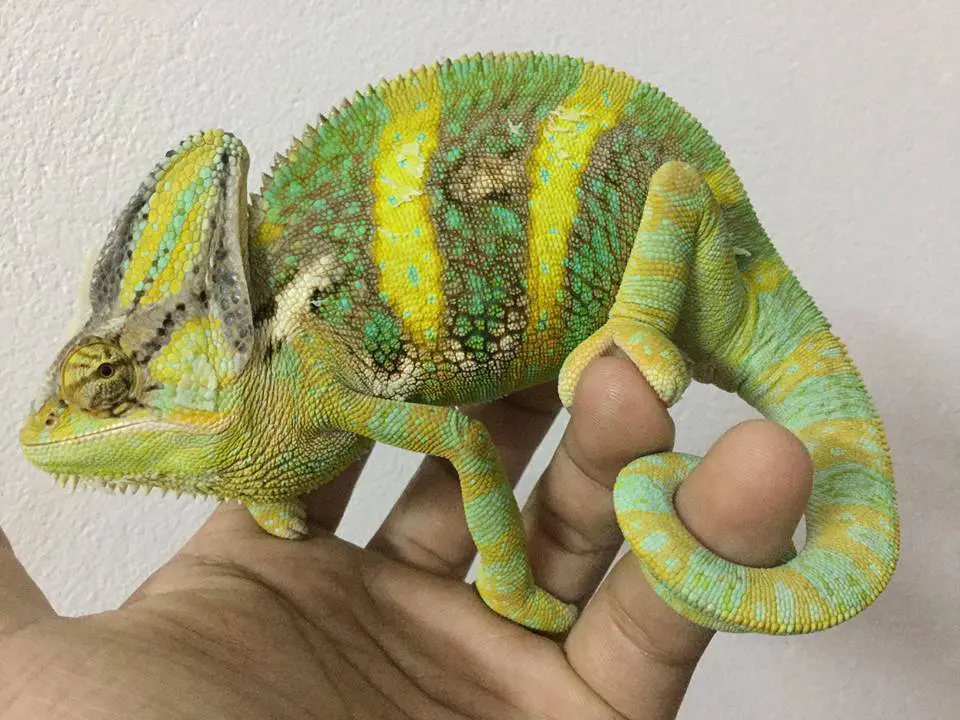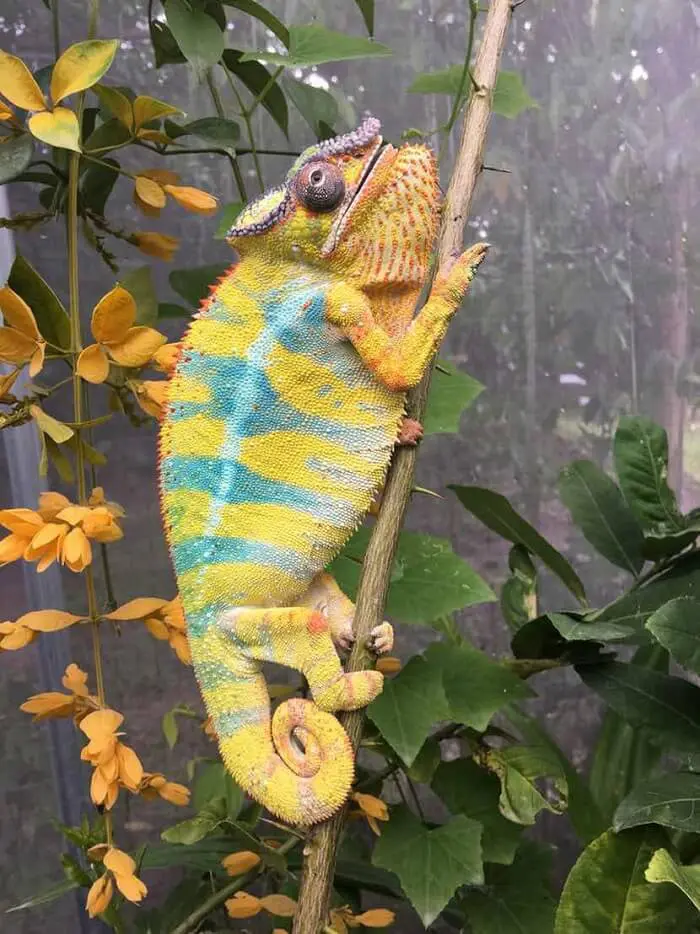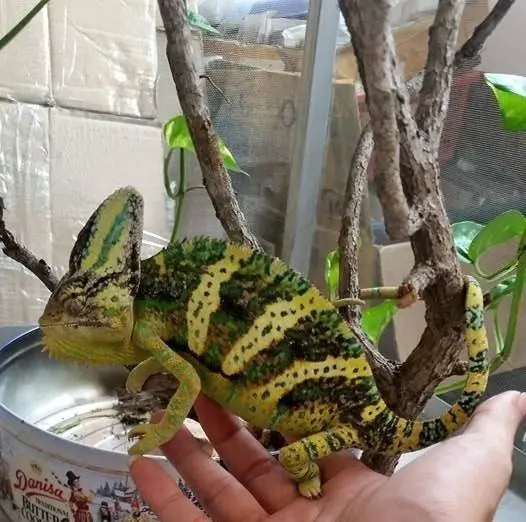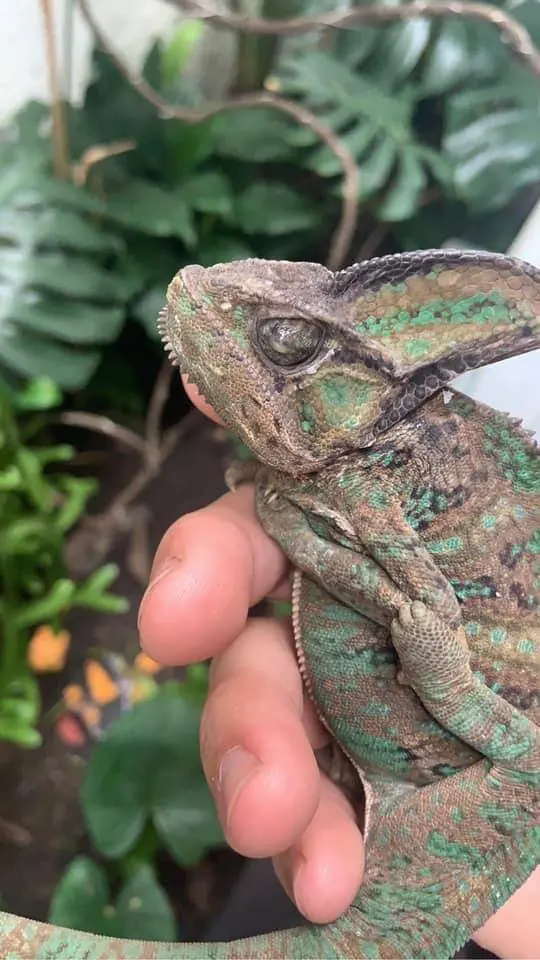When you own a chameleon, you need to get to know the body language of your pet to identify if it’s happy, stressed, or worse dying.
Chameleons communicate using coloration and body language. Knowing what your pet looks like at rest, compared to when it’s stressed, can help you identify the triggers and reduce stress in your pet.
Continue reading to find out the signs of a happy, stressed, and dying chameleon.
Chameleon Happy Signs
As mentioned above, it is very important to get to know your pet.
When your chameleon is hanging out on a branch, completely relaxed and basking in the UV light, take note of their coloration and body language.
This can help you later on when your pet suddenly changes body color or posture.
Eating
A happy chameleon will eat. Your chameleon as an adult should be eating up to six large insects every second to third day.
Remember to lightly dust your insects with a calcium supplement with each feeding to ensure your pet gets the essential vitamins and minerals it needs to remain healthy.
Exploring
Depending on the chameleon you have, you may find it in the branches and vines you have put in the enclosure, slowly exploring its surroundings. Veiled chameleons, for example, are very active during the day.
If your pet is hiding and not moving around, then it is not a happy pet.
Moderate to Dull Coloration

A happy chameleon is almost dull in coloration. If you have taken the time to get to know your pet, then you will know its normal coloration.
They should not be too dark or too bright, as these are both signs of stress.
Your pet should be moderate in color, which is a sign it is happy and relaxed.
Further Reading: Understand other colors with this chameleon color chart.
Slightly Curved Tail
A happy chameleon will hang out in the branches and vines in the enclosure. The tail is slightly curled, usually wrapping over or around the branch. Your pet should look comfortable and relaxed.

Eyes Exploring
When you look at your chameleon, the eyes should slowly explore its surroundings. They move their eyes as they look at what is going on around them.
The eyes should not be darting around, as though your pet looks nervous or alarmed.
Chameleon Stressed Signs
Stress can be exceptionally dangerous to your chameleon pet.
If your pet is regularly exposed to a stressful situation, it will not only stop reproduction and growth but can lead to illness and death.
It is very important to be able to identify the stress body language of your chameleon, so you can try and eradicate the stress as soon as possible.
Further Reading: Veiled chameleon growth chart.
Turning Sideways
When a chameleon is stressed or wants to protect its territory, it turns sideways.
Turning to the side immediately makes the chameleon look bigger than it is while giving off a vivid color display.
Gaping
If your chameleon has become very stressed, it may gape. Gaping is holding the mouth open while breathing, a definite sign there is something seriously wrong.
Hissing and Biting
Hissing and biting is a sign of stress in chameleons.
New chameleon owners that try and handle their pets too soon may experience their pet hissing at them, push it too far and they will take a bite.
Changes in Coloration
When a chameleon is stressed, it communicates it through color and posture. You may notice your pet is darker or even brighter in color than it is normally.
Posture
It’s not uncommon for a stressed chameleon to hide, almost clinging to the branches of its enclosure. They often flatten their bodies and sometimes rock back and forth.
Loss of Appetite
It’s not uncommon for a chameleon to not eat for a few days to a couple of weeks after moving to a new home. But they will start eating as they settle in.
If your chameleon has stopped eating and is acting differently, then look for what may be causing stress inside the enclosure.
Diarrhea
It’s not uncommon for a stressed chameleon to develop diarrhea with an exceptionally bad smell.
Trying to Escape
If your chameleon is trying to get out of the enclosure at every opportunity, then it’s time to identify what is wrong with the habitat.
You may find that your female chameleon is digging at the bottom of the enclosure, which can be a sign of her being gravid and needing to lay eggs.
Reduce the risk of egg binding, by providing a safe place for her to lay the eggs and reduce stress.
Further Reading: How to tell if you have a male or female chameleon.
Aggression

Chameleons prefer it when they are hanging onto a branch or vine in the enclosure, so if your pet is suddenly spending a lot of time on the floor of the enclosure, there is cause for concern.
Another sign of stress that must be dealt with quickly is when your tolerant chameleon suddenly becomes aggressive towards you.
Further Reading: How to tame an angry chameleon.
Chameleon Dying Signs
The problem with chameleons is that they are able to hide sickness until the problem is serious.
This usually means by the time you notice a problem, your pet is already dying and needing urgent veterinarian treatment.
Sunken Eyes

Healthy chameleons have eyes that are alert and constantly exploring their surroundings.
A dying chameleon will have sunken eyes, which means you need urgent veterinarian diagnosis and treatment.
Lethargy
Most captive chameleons become tolerant of their owners and will spend time exploring their habitats and enjoys time outside their enclosures.
When your usually active chameleon starts to become lazy and lethargic, it is time for concern.
Sagging Skin
Chameleons have relatively tight skin on their bodies, but once they become dehydrated, often due to not eating or drinking, then the skin will start to sag.
The reason your pet may not be eating and drinking could be due to illness, infection, or ongoing stress, which is causing your pet to slowly die.
Weight Loss
Weight loss is always a cause for concern when it comes to chameleons.
Most chameleons, especially veiled chameleons will over-eat, given half the chance. Therefore, it should be a serious cause for concern if you notice your pet is losing weight.
Your vet may also request a fecal sample, helping them identify the cause of the weight loss and see if there is anything they can do to help your pet get back to health.
Unusual Color
If you know the normal relaxed and happy color of your pet and the stressed colors, then you will be quick to notice if your pet is displaying an unusual color.
This means you will want to seek veterinary treatment soonest.
Summary
Knowing the signs of a happy chameleon and monitoring your pet regularly can help you quickly identify when there is or could be a problem.
Stresses should be eliminated as quickly as possible to reduce the risk of illness.
Remember that chameleons tend to mask illness, so keep an eye on your pet for any signs that it could be dying to ensure it gets the veterinary care it needs.